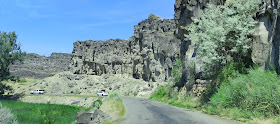During the Pleistocene Era, Ruby Valley, which runs along the eastern side of the Ruby Mountains, was covered by the 200’ deep Franklin Lake. Today the Franklin lakebed supports large ranches in the north and the 37,632-acre open-water marsh of the wildlife refuge in the south. The ecosystems in the refuge - riparian habitats, marsh, meadows, and shrub-steppe – provide homes for a diversity of wildlife seldom found in the high desert.
An auto tour travels along seven miles of gravel roads on top of the dikes. The tour starts at the Bressman Cabin, a log house built by Jacob Bressman, his daughter Deby, and son-in-law Lew Benson in 1880. We drove the straight section of the tour and walked/rolled the Brown Dike loop at the southern end. Walking is the best way to spot the many birds along the shoreline and in the grasses.
There’s a pull off by the Bressman cabin with informative signs which are too far away to be read without leaving your vehicle. Rough, hilly terrain make access difficult. The refuge headquarters was closed during our visit but it looked to be accessible. To walk the dike roads, we parked across from the vault toilet at Brown Dike Road where there’s a short paved walkway and an attempt at accessibility. The gravel road is a little rough for rolling even with my FreeWheel but worth the effort to get a close up look at the wildlife.
South Ruby Campground is located south of the headquarters. We opted to camp on public land and drove about 1/2 south of the vacation cottage settlement of Shanty Town and turned west onto a dirt road that headed to the forest. After just 1/3 mile the road opens to an large campsite under the trees but road itself is narrow and has a couple of large rocks in the middle – not good for low clearance or wide vehicles. We couldn’t get level plus the hot day brought out flies so we backtracked down the road and found a spot with low vegetation that looked like it had been used as a camp sometime in the past. We had nice breeze and a beautiful view of the marsh. : –)



The tour route, the refuge headquarters parking lot, and the parking lot at Brown Dike Road are all suitable for RVs. Ruby Valley Road from where we camped north to Neff Mill is a gravel road for 35 miles but whatever is used to harden the surface works well. It’s the best gravel road we driven on (better than many paved roads!) although there are a few washboard sections. It’s suitable for RVs.
Refuge 40.20196, -115.49309





















































